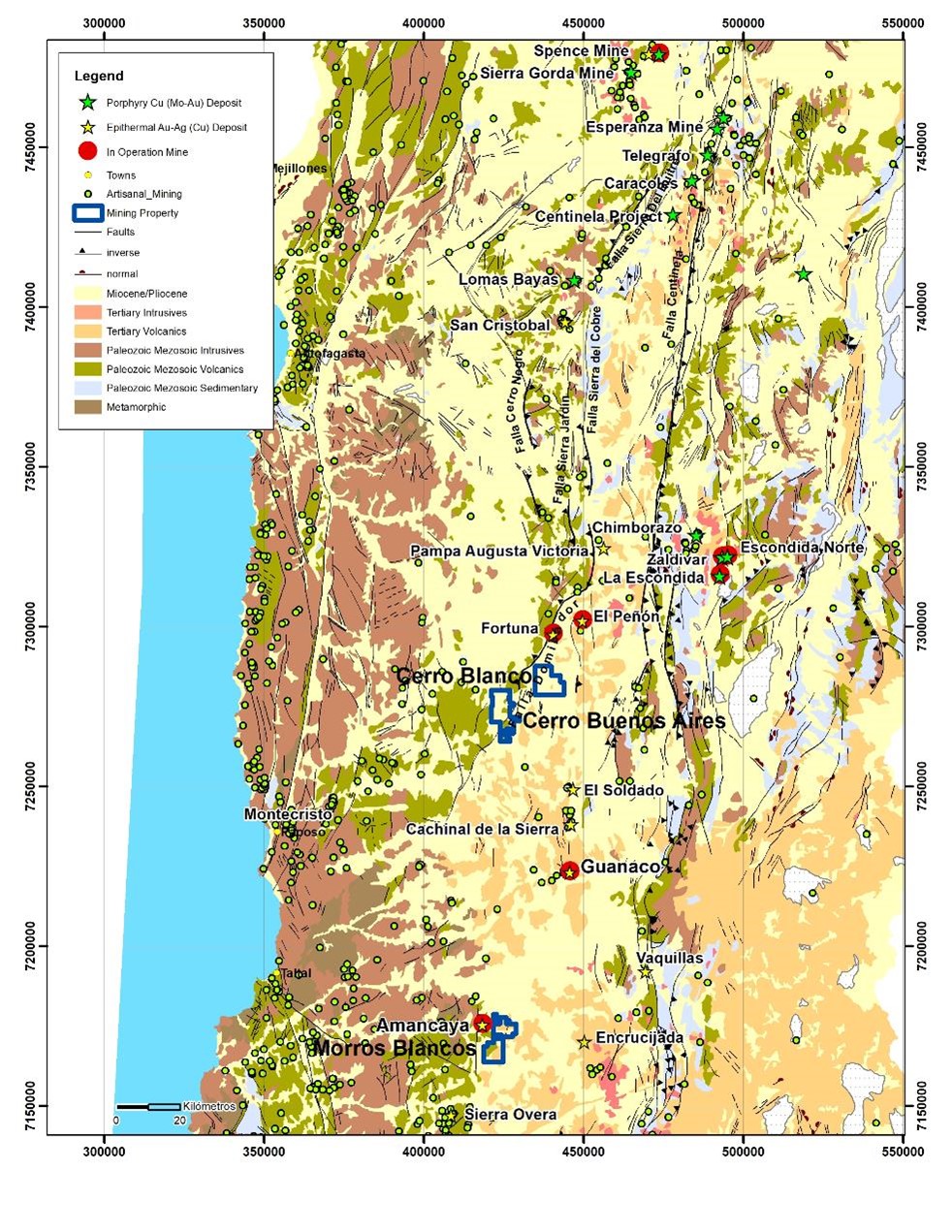Pampa Metals Completes Geological Mapping at its Cerro Buenos Aires Project with Identification of Potential Porphyry Targets
Pampa Metals Corp. has announced a technical update on its Cerro Buenos Aires project in northern Chile, revealing significant geological advancements. A comprehensive mapping exercise identified at least two porphyry-related targets, with potential for more. The project is strategically located along the Dominador Fault Zone, which is known for its mineral-rich deposits. Preliminary drilling results suggest promising copper and gold anomalies. The company is now planning to initiate a drill program, subject to COVID-19 restrictions, aiming to further explore these targets.
- Identification of at least two porphyry-related targets at Cerro Buenos Aires.
- Promising geological mapping indicating potential mineral deposits.
- Strategically located along the mineral-rich Dominador Fault Zone.
- Historical drilling showed anomalous copper and gold values.
- Limited historical drilling data with only 9 RC holes reported.
- Further electrical geophysical surveys required to refine targets.
VANCOUVER, BC / ACCESSWIRE / April 28, 2021 / Pampa Metals Corp. ("Pampa Metals" or the "Company") (CSE:PM)(FSE:FIRA)(OTC PINK:PMMCF) is pleased to provide a technical update on progress at its Cerro Buenos Aires project in northern Chile, having completed a comprehensive geological mapping exercise with the identification of two porphyry-related targets, and the potential to host yet more.
Summary
The geological context of the Cerro Buenos Aires project is dominated by its location on the western edge of the Paleocene-Eocene magmatic and mineral arc of northern Chile, along the important, regional, Dominador Fault Zone. The Dominador Fault Zone continues to the north and links up with the Sierra del Cobre and Sierra del Buitre faults, where the Lomas Bayas porphyry copper mine is located. The western margins of the magmatic arc represent a favorable corridor for magmatic emplacement with associated mineral deposits.
Geological mapping has shown that three hills with rocky outcrops, aligned north-south over approximately 12 km of strike, and separated by post-mineral, gravel filled "pampas", reveal intense hydrothermal alteration ranging from advanced argillic through to phyllic, including the presence of possibly porphyry-related quartz veinlets in discrete areas, and with the presence of tourmaline breccias in the north. Historic geophysical and geochemical data show a variety of resistive and magnetic features, combined with base metals and trace-pathfinder geochemical anomalies, suggesting the presence of at least two, and possibly more, porphyry copper centres. The large, post-mineral covered areas require further electrical geophysical coverage to help refine additional targets. Currently, two clear target areas with porphyry Cu-Au (or porphyry Au-Cu) potential have been identified at Cerro Buenos Aires hill and Cerro Chiquitin.
Julian Bavin, CEO of Pampa Metals, commented: "The Company is pleased with its technical progress to date, and is encouraged by the confirmation of good potential for porphyry related systems at its Cerro Buenos Aires project. The two target areas outlined by the geological mapping might be connected given the large expanses of post-mineral cover between geological outcrops, and the presence of a series of potentially prospective magnetic and resistive features from geophysical data. Further work is required, but Pampa Metals is moving close to implementing its first drill program, subject to Covid-related restrictions, with a selection of targets from its Cerro Buenos Aires and Redondo-Veronica projects."
Technical Report - Cerro Buenos Aires
Geological mapping at 1:5,000 scale of the 7,600-hectare Cerro Buenos Aires (CBA) project located along the Paleocene Belt of northern Chile has been completed generating a series of technical layers of information including lithology, hydrothermal alteration, structure, and mineralisation.
The project is situated approximately 130 km in a straight line southeast of the coastal port city of Antofagasta, and alongside the Pan-American Highway, with excellent infrastructural attributes. The El Peñón gold-silver (Yamana) and Lomas Bayas copper (Glencore) mines are located along trend some 35 km to the northeast and 135 km to the north-northeast, respectively.
CBA lies along the Dominador Fault Zone, which is one of a series of important fault systems that exert structural controls on the locations of a series of mineral deposits along the Paleocene magmatic arc, and particularly the productive western margins of the arc.
The geology of CBA has been mapped on three topographic highs aligned north-south over approximately 12 km of strike, the largest of which is situated in the southern portion of the project and corresponds to Cerro Buenos Aires hill itself with a maximum altitude of 2,188m. Cerro Intermedio is located about 5 km to the north, and Cerro Chiquitin a further 3 km to the north, at progressively lower elevations. The three principal outcrops are surrounded by post-mineral, gravel-filled "pampas", particularly between the outcrops and in the central-western and north-western portions of the project area.
The mapped geology on CBA hill is dominated by a column of porphyritic basalts and andesites at the base and porphyritic dacites and andesite tuffs in the upper part, with rhyolite tuffs at the top. A rhyolite-dacite porphyry or dome complex outcrops on the eastern flank of CBA hill. A monzo-dioritic porphyry, which may be an early intrusive phase, outcrops to the southwest. Geologic age dating information shows that the volcanic host rocks and intrusive rocks, as well as the hydrothermal alteration assemblages, correspond to the productive porphyry stage of the Paleocene magmatic arc of northern Chile.
Outcropping rocks at CBA are typically affected by advanced argillic hydrothermal alteration assemblages, for the most part intense, ranging from quartz-alunite to pyrophyllite and dickite, and with a variety of breccias occurring, including magmatic-hydrothermal, phreatic, crackle and explosive components. Vuggy quartz structures are common. Evidence from limited historic drilling also shows a transition to sericitic (phyllic) alteration at shallow depths.
Importantly, close to the summit of CBA hill, a discrete outcrop of thin, sinuous, and banded gray quartz veinlets occurs together with some D-type veinlets, which seem to confirm that CBA corresponds to a hydrothermal system at the transition from the epithermal to porphyry environments.
Historic geophysical data, including heli-borne magnetics and resistivity (HoisTEM) data, reveal magnetic and resistive features consistent with possible magmatic centers prospective for porphyry Au-Cu or porphyry Cu-Au systems. Historic surface geochemistry also reveals modest Cu-Mo anomalies, together with Pb, and intense As-Sb-Bi pathfinder anomalies, also suggesting the transition from epithermal to porphyry environments.
At Cerro Intermedio, rhyolite and andesite tuffs with intermediate argillic alteration outcrop on the east flank, and are separated by a north-south fault from rhyolite tuffs spatially associated with a rhyolite dome to the west. The western outcrops have been affected by advanced argillic alteration, including north-south oriented vuggy quartz ledges and other replacement structures. The hydrothermal system appears slightly deeper than that at CBA hill, which can be explained by the difference in elevation of about 340 m between the two outcrops.
Cerro Chiquitín to the north stands out for a tourmaline matrix magmatic-hydrothermal breccia in contact with andesitic tuffs and a diorite porphyry, which in turn are in contact with a fine-grained diorite on the east flank of the outcropping area. The tourmaline breccia shows weak phyllic alteration, with some D veinlets and subparallel A-type quartz veins on the east flank in the fine-grained diorite. The volcanics and diorite porphyry are affected by contact metasomatism with intermediate argillic alteration superimposed on biotite-magnetite alteration. Thin north-south and northeast trending quartz ledges with dumortierite halos cut the tourmaline breccia, suggesting Cerro Chiquitín is part of an uplifted block that reveals the roots of a CBA-type hydrothermal system, and is consequently more deeply eroded.
Tourmaline breccias are common in Paleocene porphyry copper systems of northern Chile and have been described at Lomas Bayas, Sierra Gorda, Pampa Lina, and Spence, so the tourmaline breccia encountered at Cerro Chiquitín, together with the D- and A-type quartz veinlets, is considered important evidence for a porphyry system in the vicinity.
Historic drill testing at CBA is restricted to 9 RC holes for which results are available to the Company, particularly limited given the size of the hydrothermal alteration system(s) and the extent of post-mineral cover, and these holes are supportive of the interpretations made. Historic drilling includes 3 approximately 300m RC holes drilled by Teck in 2018 directed towards a small magnetic high under post-mineral cover to the immediate east of CBA hill. These holes cut approximately 80m of gravel cover, followed by supergene argillic alteration in a leached capping for a further 50 to 150m, and then sericitic alteration to the end of the holes, none of which cut the source of the magnetic feature. Drill hole CBA036 on the southwest flanks of CBA hill cut anomalous copper and arsenic values throughout the drill hole (420m @ 84 ppm Cu and 43.5 ppm As respectively), including 40m @ 304 ppm Cu (258 - 298m) and 2m @
CBA hill and Cerro Chiquitin are currently regarded as priority drill target areas, but data integration is continuing, and some electrical geophysical surveying is required to help refine targets and is currently being planned.
Technical information in this news release has been approved by Mario Orrego G., geologist and a registered member of the Chilean Mining Commission and a qualified person as defined by National Instrument 43-101. Mr. Orrego is a consultant to the company.
Reference to existing or historic mines and projects, and the overall mineral potential of Chile, is for reference purposes only. The reader is cautioned that there is no evidence to date that comparable resources could be found on Pampa Metals' properties.
ABOUT PAMPA METALS
Pampa Metals is a Canadian company listed on the Canadian Stock Exchange (CSE: PM). Pampa Metals owns a
ON BEHALF OF THE BOARD
Julian Bavin | Chief Executive Officer
INVESTORS CONTACT
Ioannis (Yannis) Tsitos | Director
investors@pampametals.com
www.pampametals.com
Neither the CSE nor the Investment Industry Regulatory Organization of Canada accepts responsibility for the adequacy or accuracy of this release.
FORWARD-LOOKING STATEMENT
This news release contains certain statements that may be deemed "forward-looking statements". All statements in this release, other than statements of historical fact, that address events or developments that Pampa Metals expects to occur, are forward-looking statements. Forward-looking statements are statements that are not historical facts and are generally, but not always, identified by the words "expects", "plans", "anticipates", "believes", "intends", "estimates", "projects", "potential", "indicate" and similar expressions, or that events or conditions "will", "would", "may", "could" or "should" occur. These include statements regarding our future exploration plans and results of existing plans. These statements are subject to various risks, including that results will not be as anticipated, or that timing may be impacted by restrictions on travel and work imposed due to the Covid-19 pandemic. Although Pampa Metals believes the expectations expressed in such forward-looking statements are based on reasonable assumptions, such statements are not guaranteeing of future performance and actual results may differ materially from those in forward-looking statements.
Cerro Buenos Aires Project - Simplified Regional Geology and Project Location - Regional Mines & Deposits

Cerro Buenos Aires Project - Simplified Property Geology & Hydrothermal Alteration - Showing Principal Areas of Interest to Date
SOURCE: Pampa Metals Corp.
View source version on accesswire.com:
https://www.accesswire.com/642635/Pampa-Metals-Completes-Geological-Mapping-at-its-Cerro-Buenos-Aires-Project-with-Identification-of-Potential-Porphyry-Targets
FAQ
What recent announcement did Pampa Metals Corp (PMMCF) make regarding its Cerro Buenos Aires project?
What geological findings were reported by Pampa Metals at Cerro Buenos Aires?
When does Pampa Metals plan to begin drilling at the Cerro Buenos Aires project?
Where is the Cerro Buenos Aires project located?








